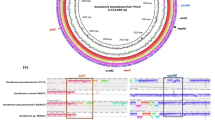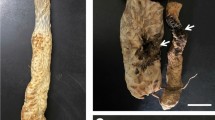Abstract
Thirty-one loquat orchards (Eriobotrya japonica ‘Algerie’) with plants exhibiting decline symptoms were surveyed between 2004 and 2007 in the province of Alicante, Spain. Twenty-eight representative isolates with Cylindrocarpon-like asexual morphs recovered from affected roots were included in this study, with the objective to characterize them by means of phenotypical characterization, DNA analysis and pathogenicity tests. Dactylonectria alcacerensis, D. torresensis and Ilyonectria robusta were identified based on morphological and cultural characteristics as well as DNA sequence data for part of histone H3, with D. torresensis the most frequent species. All of them are reported for the first time on loquat, and I. robusta is reported for the first time in Spain. In addition, one species is newly described, Cylindrodendrum alicantinum. Pathogenicity tests with representative isolates showed that these species were able to induce typical root rot disease symptoms, affecting plant development or even leading to plant death. This research demonstrates the association of species belonging to the genera Cylindrodendrum, Dactylonectria and Ilyonectria with root rot of loquat and loquat decline in the province of Alicante (eastern Spain). This information should be considered for the improvement of the current management strategies against these soil-borne pathogens when establishing new loquat plantations or introducing new susceptible fruit crops in the region.



Similar content being viewed by others
References
Agustí-Brisach, C., & Armengol, J. (2013). Black-foot disease of grapevine: an update on taxonomy, epidemiology and management strategies. Phytopathologia Mediterranea, 52, 245–261.
Agustí-Brisach, C., Gramaje, D., García-Jiménez, J., & Armengol, J. (2013a). Detection of Ilyonectria spp. in the grapevine nursery propagation process in Spain. European Journal of Plant Pathology, 137, 103–112.
Agustí-Brisach, C., Gramaje, D., García-Jiménez, J., & Armengol, J. (2013b). Detection of black-foot and Petri disease pathogens in natural soils of grapevine nurseries and vineyards using bait plants. Plant and Soil, 364, 5–13.
Aiello, D., Guarnaccia, V., Vitale, A., Cirvilleri, G., Granata, G., Epifani, F., Perrone, G., Polizzi, G., Groenewald, J. Z., & Crous, P. W. (2014). Ilyonectria palmarum sp. nov. causing dry basal stem rot of Arecaceae. European Journal of Plant Pathology, 138, 347–359.
Booth, C. D. (1966). The genus Cylindrocarpon. Mycological Papers (CMI), 104, 1–56.
Brayford, D. (1993). Cylindrocarpon. In L. L. Singleton, J. D. Mihail, & C. M. Rush (Eds.), Methods for research on soilborne phytopathogenic fungi (pp. 103–106). St. Paul: APS Press.
Cabral, A., Groenewald, J. Z., Rego, C., Oliveira, H., & Crous, P. W. (2012a). Cylindrocarpon root rot: multi-gene analysis reveals novel species within the Ilyonectria radicicola species complex. Mycological Progress, 11, 655–688.
Cabral, A., Rego, C., Nascimento, T., Oliveira, H., Groenewald, J. Z., & Crous, P. W. (2012b). Multi-gene analysis and morphology reveal novel Ilyonectria species associated with black foot disease of grapevines. Fungal Biology, 116, 62–80.
Calabrese, F. (2006). Origen de la especie. In M. Agustí, C. Reig, & P. Undurraga (Eds.), El cultivo del níspero japonés. España: Pontificia Universidad Católica de Valparaíso, Chile and Universidad Politécnica de Valencia.
Chaverri, P., Salgado, C., Hirooka, Y., Rossman, A. Y., & Samuels, G. J. (2011). Delimitation of Neonectria and Cylindrocarpon (Nectriaceae, Hypocreales, Ascomycota) and related genera with Cylindrocarpon-like anamorphs. Studies in Mycology, 68, 57–78.
Crous, P. W., Gams, W., Stalpers, J. A., Robert, V., & Stegehuis, G. (2004a). MycoBank: an online initiative to launch mycology into the 21st century. Studies in Mycology, 50, 19–22.
Crous, P. W., Groenewald, J. Z., Risede, J. M., & Hywel-Jones, N. L. (2004b). Calonectria species and their Cylindrocladium anamorphs: species with sphaeropedunculate vesicles. Studies in Mycology, 50, 415–429.
Crous, P.W., Verkleij, G.J.M., Groenewald, J.Z., Samson, R.A. (Eds.) (2009). Fungal biodiversity. CBS laboratory manual series 1. Centraalbureau voor Schimmelcultures, Utrecht.
Dhingra, O. D., & Sinclair, J. B. (1995). Basic plant pathology methods (2nd ed.). Boca Raton: CRC Press.
Erper, I., Agustí-Brisach, C., Tunali, B., & Armengol, J. (2013). Characterization of root rot disease of kiwifruit in the Black Sea region of Turkey. European Journal of Plant Pathology, 136, 291–300.
Felsenstein, J. (1985). Confidence limits on phylogenies: an approach using the bootstrap. Evolution, 39, 783–791.
Gardes, M., & Bruns, T. D. (1993). ITS primers with enhanced specificity for basiodiomycetes-applications to the identification of mycorrhizae and rusts. Molecular Ecology, 2, 113–118.
Glass, N. L., & Donaldson, G. (1995). Development of primer sets designed for use with PCR to amplify conserved genes from filamentous ascomycetes. Applied and Environmental Microbiology, 61, 1323–1330.
González-Domínguez, E., Pérez-Sierra, A., Álvarez, L. A., Abad-Campos, P., Armengol, J., & García-Jiménez, J. (2008). Ethiology of decline of loquat (Eriobotrya japonica) in eastern Spain. Journal of Plant Pathology, 90(2, supplement), 179.
González-Domínguez, E., Pérez-Sierra, A., Álvarez, L. A., León, M., Abad-Campos, P., Armengol, J., & García-Jiménez, J. (2009). Agentes fúngicos presentes en plantaciones de nísperos (Eriobotrya japonica Lindl.) con síntomas de decaimiento en la provincia de Alicante. Boletín Sanidad Vegetal Plagas, 35, 453–467.
González-Domínguez, E., Rossi, V., Armengol, J., & García-Jiménez, J. (2013). Effect of environmental factors on mycelial growth and conidial germination of Fusicladium eriobotryae, and the infection of loquat leaves. Plant Disease, 97, 1331–1338.
González-Domínguez, E., Armengol, J., & Rossi, V. (2014). Development and validation of a weather-based model for predicting infection of loquat fruit by Fusicladium eriobotryae. Plos One, 9, e107547.
Halleen, F., Schroers, H. J., Groenewald, J. Z., & Crous, P. W. (2004). Novel species of Cylindrocarpon (Neonectria) and Campylocarpon gen. nov. associated with black-foot disease of grapevines (Vitis spp). Studies in Mycology, 50, 431–455.
Halleen, F., Fourie, P. H., & Crous, P. W. (2006). A review of black-foot disease of grapevine. Phytopathologia Mediterranea, 45, S55–S67.
Janick, J. (2011). Predictions for loquat improvement in the next decade. Acta Horticulturae, 887, 25–30.
Larkin, M. A., Blackshields, G., Brown, N. P., Chenna, R., McGettigan, P. A., McWilliam, H., Valentin, F., Wallace, I. M., Wilm, A., Lopez, R., Thompson, J. D., Gibson, T. J., & Higgins, D. G. (2007). Clustal W and Clustal X version 2.0. Bioinformatics, 23, 2947–2948.
Lin, S. Q. (2007). World loquat production and research with special reference to China. Acta Horticulturae, 750, 37–44.
Lombard, L., Van der Merwe, N. A., Groenewald, J. Z., & Crous, P. W. (2014). Lineages in Nectriaceae: Re-evaluating the generic status of Ilyonectria and allied genera. Phytopathologia Mediterranea, 53, 515–532.
Nirenberg, H. (1976). Untersuchungen über die morphologische und biologische Differenzierung in der Fusarium-Sektion Liseola. Mitteilungen aus der Biologischen Bundesanstalt für Land- und Forstwirtschaft, 169, 1–117.
O’Donnell, K., & Cigelnik, E. (1997). Two divergent intragenomic rDNA ITS2 types within a monophyletic lineage of the fungus Fusarium are nonorthologous. Molecular Phylogenetics and Evolution, 7, 103–116.
Petit, E., & Gubler, W. D. (2005). Characterization of Cylindrocarpon species, the cause of black foot disease of grapevine in California. Plant Disease, 89, 1051–1059.
Rayner, R. W. (1970). A mycological colour chart. Kew: British Mycological Society and CAB International Mycological Institute.
Read, N. D., Lichius, A., Shoji, J. Y., & Goryachev, A. B. (2009). Self-signalling and self-fusion in filamentous fungi. Current Opinion in Microbiology, 12, 608–615.
Reig, C., Farina, V., Volpe, G., Mesejo, C., Martínez-Fuentes, A., Barone, F., Calabrese, F., & Agustí, M. (2012). Giberellic acid and flower bud development in loquat (Eriobotrya japonica Lindl.). Scientia Horticulturae, 129, 27–31.
Samuels, G. J., & Brayford, D. (1990). Variation in Nectria radicicola and its anamorph, Cylindrocarpon destructans. Mycological Research, 94, 433–442.
Sánchez-Hernández, M. E., Ruiz-Dávila, A., Pérez de Algaba, A., Blanco-López, M. A., & Trapero-Casas, A. (1998). Occurrence and etiology of death of young olive tres in southern Spain. European Journal of Plant Pathology, 104, 347–357.
Sánchez-Torres, P., Hinarejos, R., & Tuset, J. J. (2009). Characterization and pathogenicity of Fusicladium eriobotryae, the fungal pathogen responsible for loquat scab. Plant Disease, 93, 1151–1157.
Schroers, H. J., Zerjav, M., Munda, A., Halleen, F., & Crous, P. W. (2008). Cylindrocarpon pauciseptatum sp. nov., with notes on Cylindrocarpon species with wide, predominantly 3-septate macroconidia. Mycological Research, 112, 82–92.
Soler, E., Martínez-Calvo, J., Llácer, G., & Badenes, M. L. (2007). Loquat in Spain: production and marketing. Acta Horticulturae, 750, 45–47.
Tamura, K., Stecher, G., Peterson, D., Filipski, A., & Kumar, S. (2013). MEGA6: molecular evolutionary 16 genetics analysis version 6.0. Molecular Biology and Evolution, 30, 2725–2729.
Tewoldemedhin, Y. T., Mazzola, M., Mostert, L., & McLeod, A. (2011). Cylindrocarpon species associated with apple tree roots in South Africa and their quantification using real-time PCR. European Journal of Plant Pathology, 129, 637–651.
Vitale, A., Aiello, D., Guarnaccia, V., Perrone, G., Stea, G., & Polizzi, G. (2012). First report of root rot caused by Ilyonectria (=Neonectria) macrodidyma on avocado (Persea americana) in Italy. Journal of Phytopathology, 160, 156–159.
Zhuang, W. Y., Nong, Y., & Luo, J. (2007). New species and new Chinese records of Bionectriaceae and Nectriaceae (Hypocreales, Ascomycetes) from Hubei, China. Fungal Diversity, 24, 347–357.
Acknowledgments
We acknowledge Dr. L. Lombard and Prof. Dr. P.W. Crous (CBS-KNAW Fungal Biodiversity Centre, The Netherlands) for valuable discussions and data sharing. This work was funded by the Cooperativa Agrícola de Callosa d’En Sarrià (Alicante, Spain). We would like to thank E. Soler for their technical assistance.
Author information
Authors and Affiliations
Corresponding author
Rights and permissions
About this article
Cite this article
Agustí-Brisach, C., Cabral, A., González-Domínguez, E. et al. Characterization of Cylindrodendrum, Dactylonectria and Ilyonectria isolates associated with loquat decline in Spain, with description of Cylindrodendrum alicantinum sp. nov.. Eur J Plant Pathol 145, 103–118 (2016). https://doi.org/10.1007/s10658-015-0820-7
Accepted:
Published:
Issue Date:
DOI: https://doi.org/10.1007/s10658-015-0820-7




